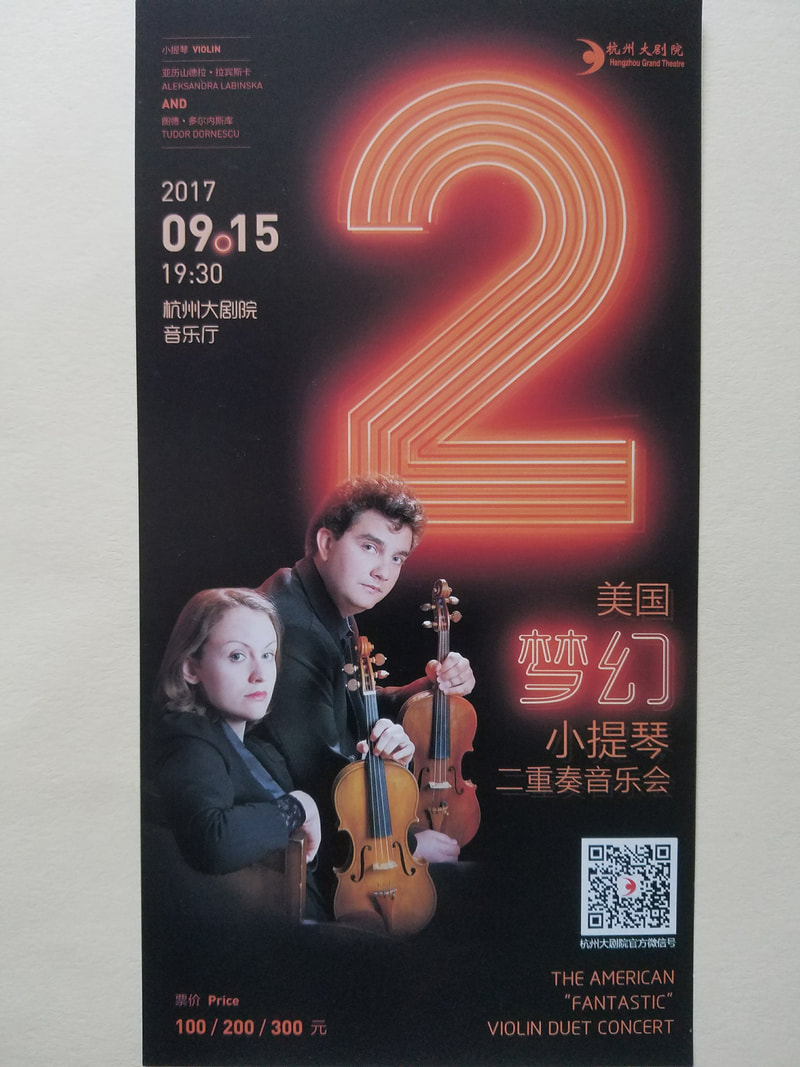Full article at http://www.classical-scene.com/2014/05/02/mirage-duo/
MAY 2, 2014 Mirage Violin Lunch No Illusion by Basil Considine
The Mirage Violin Duo’s lunchtime concert on Monday was a sweet but filling affair. Often, mid-day concerts are something of a mixed bag, like a fruit salad where the grapes are good but the pineapple has turned mushy. Although some of the musical selections were definitely older than others, no shelf life issues threatened this meal’s enjoyment.
The concert, featuring violinists Aleksandra Labinska and Tudor Dornescu, took place in the stage auditorium at First Church Cambridge. This move from First Church’s adjacent Lindsay Chapel was a welcome one; although the auditorium allows a little more hallway noise, its spaciousness and parquet floor allow sound to blossom more without becoming muddied. The auditorium windows also let in a pleasant, diffuse mid-day light that easily beat out the chapel’s dim gloominess–not a factor for the chapel’s usual night-time concerts, but definitely a plus for the lunch hour.
The musical programming consisted of a variety of material for violin duo: sonatas by Leclair and Prokofiev, a passacaglia by Handel & Halvorsen, and some small musical morsels by Bartók. Most of these pieces are standard fare for two violins, but the Bartók pieces injected a pleasant dose of novelty and uncommon flavor into the repast.
The first piece on the program was Jean Marie Leclair (1697-1764)’s Sonata for Two Violins No. 5; Dornescu took the first violin part for this piece. The Allegro ma poco was elegantly played; a passage that split a melody across the two instruments was particularly well fashioned. The following Gavotta gracioso was tenderly and lyrically delivered; the Andante and Presto that followed, less distinguished.
Ten selections from Béla Bartók’s 44 Duos for Two Violins (1931) collection followed. These short miniatures have a lovely variety of sound and give great freedom for interpretation and expression; the performers did not disappoint the opportunity. The programmatic titles such as “Teasing”, “Sorrow”, and “Bagpipes” are not as stereotypical as imagined, and evoke sometimes unexpected sounds from the instruments – especially the charming “Pizzicato”, which calls to mind a guitar or mandolin duet. These pieces were of special delight to the children in the audience.
The pièce de résistance of the concert was Prokofiev’s Sonata in C Major for Two Violins, Op. 56 (1932), for which Labinska took the lead. The performance of the second movement Allegro was a standout; the first violin’s melodic passages are often lost in the clouds of sound, but here were shaped into meaningful arcs. Labinska and Dornescu played well off each other in the blazing rollercoaster of exchanges that forms the movement’s middle section. The sound of the fourth movement became a little muddy at times, something not helped by Prokofiev’s performance markings – a looser interpretation of these directions is often helpful in shaping it.
The program ended with Johan Halvorsen (1864-1935)’s Passacaglia in G minor (1897/1914), an adaptation of music from Handel’s famous Harpsichord Suite in G minor. The Passacaglia was heard in its arrangement for two violins, rather than its more common violin-viola original. Here, too, the second section was especially noteworthy, with a beautiful and shimmering realization of the music by the two violinists. They avoided the common tendency to indulge in schmaltzy excess here, exercising just enough restraint to tantalize with the music. The difficult fast spiccato passages were expertly navigated, too, with flair and strong technique. The fourth section was suitably energetic and glowing, leading well into the intense ending. It was the aural version of baked Alaska to end the lunchtime musical meal.
Basil Considine studied music and drama at Boston University and the University of San Diego. A composer-librettist, scholar, and playwright, he was the Artistic Director of the Reduced Spice Opera Company of Brookline from 2006-2012.













